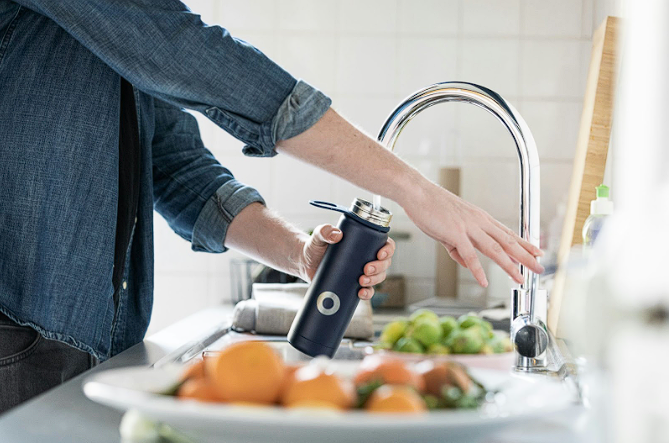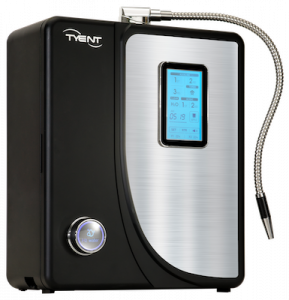Over 75% of Americans say they filter their drinking water at home, with many of them doing this process for health benefits and a desire to be more environmentally friendly. But if these Americans are switching to reverse osmosis water, they might not be getting the health benefits or making the eco-friendly impact they expect.What exactly is reverse osmosis water, and why isn’t it the clean water solution some people think it is? In this article, we’ll break down the reverse osmosis process and the dangers of reverse osmosis water.
What Is Reverse Osmosis Water?
Reverse osmosis is the process by which pressure forces water through a semi-permeable membrane to remove impurities. The result is two streams of water. The treated water, called the permeate, then is directed to where it can be consumed. Meanwhile, the system removes the rejected, contaminated water, called the concentrate. Reverse osmosis water is the treated water that’s safe to drink.
What Contaminants Does RO Remove?
Reverse osmosis can remove some contaminants, but it isn’t the best option for filtering your water. Reverse osmosis removes contaminants, including:
- Ions and metals like arsenic and mercury
- Particles like asbestos and cryptosporidium
- Pesticides like endrin and pentachlorophenol
- Radionuclides like radium and uranium
Knowing that reverse osmosis has these capabilities sounds good in theory, but the problem is that reverse osmosis isn’t picky about what it removes. While it can remove contaminants, it also removes helpful and healthful nutrients and minerals in your water, such as calcium and magnesium.
How Reverse Osmosis Works
The first step of the reverse osmosis process is to install your reverse osmosis filtration system, which also requires an intake pump set up at the water source. Then, pre-treatment begins, in which larger solids like carbonic acids and sediments are removed from the water to protect the semi-permeable membrane. During this step, bacteria are also killed by oxidizing biocides like chlorine.
A high-pressure pump then moves the water toward the semi-permeable membrane. A pressure vessel then allows the water to make contact with the membrane. The energy put into the high-pressure pump can now be recovered and redirected to the concentrate flow.
The water is then remineralized to protect the inside of the water storage and pipes by adding caustic soda or lime to prevent corrosion. During this post-treatment phase, water is disinfected again against bacteria or pathogens that may have bypassed the filtration process.
This process also removes minerals that are good for you, such as potassium, which protects your internal organs, and zinc, which is essential for your circulatory system and immune system. The water you get with reverse osmosis has a very low mineral count. While the water may seem clean, it’s also not delivering the minerals and nutrients your body needs, in comparison to the water ionizers, like Tyent’s ionizers, can create. This water adds more nutrients and minerals to your water, rather than taking them out the way reverse osmosis does.
Things to Know About Reverse Osmosis Water
If you’re interested in installing a reverse osmosis filtration system in your home, here are a few things to consider first:
1. Reverse Osmosis Water is “Dead” Water
Getting rid of contaminants sounds like a good solution for providing clean drinking water. However, the issue is that reverse osmosis, in a way, is almost too thorough. Reverse osmosis doesn’t distinguish between good-for-you minerals and bad-for-you pollutants. To explain this more clearly, think about where RO water is often used: war zones, places that have suffered natural disasters and have no functioning infrastructure, various emergency situations, and so on. It’s an effective short-term measure as it can turn dirty, brackish, and undrinkable water into clean water.
Ultimately, though, it should only be a short-term fix, as reverse osmosis also takes away essential minerals people should be getting from their drinking water. This water is considered “dead” because the system cannot differentiate between dangerous contaminants and vital minerals, so everything must go.
If you drink reverse osmosis water on a long-term basis, it can potentially be harmful to your health. Why? Because water depleted of all its minerals is unstable. It wants to re-mineralize itself by seeking out sources of minerals. Inside your body, it will find them, mainly in your teeth and bones. Demineralized water will actively attempt to leach essential minerals from your body.
“Drinking water should contain minimum levels of certain essential minerals . . . . Sufficient evidence is now available to confirm the health consequences from drinking water deficient in calcium or magnesium.”
– Frantisek Kozisek, National Institute of Public Health, Czech Republic
2. It Doesn’t Hydrate as Well as Alkaline Water
When a reverse osmosis machine filters the water, it removes antioxidants and electrolytes — the combination of dissolved salts, magnesium, potassium, and calcium essential for regulating water in cell structures and maintaining nerve impulses.
Without these essential elements, the water itself is less hydrating and nourishing for your body. On the other hand, alkaline water, like the water produced through ionizers, has been shown to boost hydration. It can also improve your energy levels and help slow the signs of aging.
3. Reverse Osmosis Is Extremely Wasteful
Reverse osmosis is exceptionally wasteful, with a huge amount of water lost in the process. According to the Environmental Protection Agency (EPA), a typical reverse osmosis system will generate five or more gallons of contaminated wastewater for every gallon of treated water produced. Some of the more inefficient systems on the market generate a whopping 10 gallons of rejected water for every gallon of clean water.
In other words, the ratio of clean water to wastewater is tiny! In comparison to water ionizers, reverse osmosis systems typically have a significantly higher amount of wastewater. Some Tyent ionizers go even further by producing 40% less wastewater than other ionizers.
4. The World Health Organization (WHO) Recommends Not Drinking It
The WHO released a report warning people about prolonged usage of filtration systems that remove important minerals from drinking water. This report acknowledges that we do not yet know the long-term effect of drinking water produced through reverse osmosis. Although the report addresses that more research is needed to fully understand the impact of the long-term consumption of demineralized water, the WHO notes that there are several known health effects.
Demineralized water contains little or no calcium or magnesium. A previous study found that areas with soft water that are low in these minerals have a higher morbidity and mortality rate from cardiovascular disease. Further studies have found that this soft water may also affect a person’s risk for certain cancers and the health of their future children.
Although reverse osmosis water is supposed to be clean of contaminants, the WHO notes that drinking demineralized water actually places you at an increased risk of consuming toxic metals, as water low in calcium and magnesium has a lower protective capacity. Low-mineralized water is highly aggressive to materials it comes in contact with, so it readily dissolves metals and other organic substances it touches.
The WHO also points out that, although reverse osmosis systems should be clean of all bacteria, this is not always the case, and the aggressive water can also result in bacteria contamination.
Best Alternative to Reverse Osmosis Water
Instead of investing in a reverse osmosis water filtration system, an expensive clean water solution that may not give you the clean water you were hoping for, consider an ionizer. Water ionizers can remove contaminants from your source water, but that’s where the similarities between ionized water and reverse osmosis end.
Tyent water ionizers filter out toxins, dangerous residues, pharmaceuticals, heavy metals, and more from your water, but they don’t remove essential minerals. On the contrary, the ionization process actually adds more healthy minerals.
Not only do you get all the benefits of drinking alkaline water, but Tyent ionizers also add thousands of bubbles of naturally occurring molecular hydrogen. Hydrogen water has been shown to improve your energy, reduce signs of aging, reduce inflammation, boost metabolic health, and much more. Tyent offers ionizers that have the highest levels of therapeutic hydrogen on the market.
Tyent ionizers are trusted by doctors, athletes, and more around the world. If you’re looking to use reverse osmosis to filter out pollutants, consider the fact that Tyent ionizers use Dialpure filters, which have the same filtration power as kidney dialysis machines. With Tyent ionizers, you say goodbye to over 200 dangerous contaminants — and hello to the nutrients and minerals your body needs.
Learn More About Reverse Osmosis Water
Do you have questions about reverse osmosis? Read our FAQ to learn more about how reverse osmosis works and why it may not be the best clean drinking water solution.
Is it healthy to drink reverse osmosis water?
Reverse osmosis can be a life-saving, safe drinking water solution. In areas where clean water is scarce, it can treat brackish, contaminated water and make it safe for consumption. The problem is that while it’s a great short-term solution, it’s not a good long-term option.
Reverse osmosis results in aggressive, demineralized water. In the long run, this type of water can have negative health effects, such as the potential for drinking toxic metals that have leached into the water and a lack of essential minerals that your body needs to function.
If reverse osmosis water is the only clean water available to you, and you know that any other water available is contaminated, the reverse osmosis water is the healthier option. But you should not rely on it for long-term use. A better option is an ionizer, which has the power to filter out pollutants without depriving you of the necessary minerals. Tyent ionizers filter out over 200 contaminants while also providing you with the highest levels of antioxidants and molecular hydrogen possible.
What is the disadvantage of reverse osmosis water?
Reverse osmosis water has numerous disadvantages. Getting water through reverse osmosis is extremely wasteful due to the abundance of wastewater it produces, compared to Tyent ionizers, which can even produce less wastewater than other ionizers on the market. Reverse osmosis also removes essential minerals during the filtration process, not just contaminants.
If you’re only drinking reverse osmosis water, you may not be getting all the minerals you need. Even worse, your body might start pulling essential minerals from other places in your body, namely your teeth and bones. Reverse osmosis water is also not as hydrating as alkaline water or hydrogen water, both of which you can get from Tyent’s ionizers, and lacks other benefits of these types of water, such as anti-aging effects.
What does reverse osmosis water do?
Reverse osmosis uses a semi-permeable membrane to remove impurities from water. Reverse osmosis water can be a short-term solution when you lack access to clean drinking water. It can be helpful when water is scarce, but it shouldn’t be relied upon for long-term use.
Is reverse osmosis the same as distilled water?
Reverse osmosis water is not the same as distilled water. Distillation is the process of boiling water, capturing the condensation, and allowing it to condense back into water, where the water is separated from impurities. Distillation will kill bacteria and microbes, but it does not remove other chemicals and minerals. Neither reverse osmosis water nor distilled water has the benefits of the alkaline water and hydrogen water that can be produced with Tyent’s ionizers.
Reverse Osmosis Water: The Bottom Line
You want clean, healthy drinking water. So what’s the best way to get it? Reverse osmosis has become common in many homes, but research shows it shouldn’t be used long-term. Reverse osmosis can be extremely wasteful and removes the essential minerals you need to consume to stay healthy.
Tyent ionizers not only remove impurities but also give you numerous other benefits. With the alkaline water made by Tyent ionizers, you get better hydration, anti-aging benefits, increased energy, and so much more. If you’re thinking about installing a reverse osmosis filtration system in your home, consider checking out Tyent’s ionizers instead. You’ll get the filtration you need, plus the minerals you won’t get with reverse osmosis.




![Kangen Water vs. Reverse Osmosis: What’s the Difference? [2025] Kangen Water vs. Reverse Osmosis: What’s the Difference? [2025]](https://www.tyentusa.com/blog/wp-content/uploads/2024/08/Screenshot-2024-08-15-000646-300x141.png)





